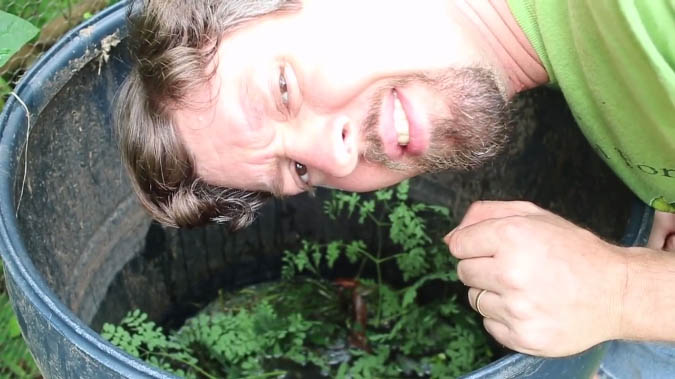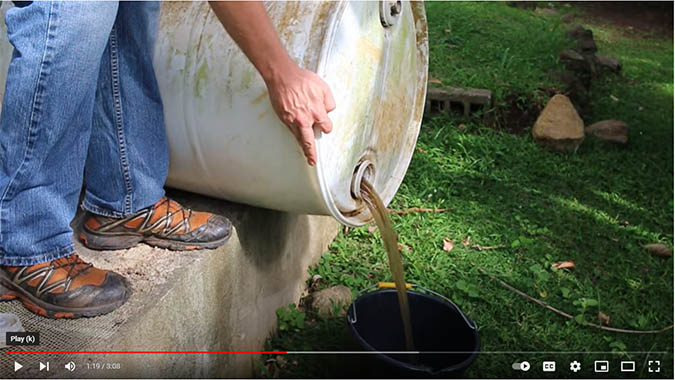I used to spend a lot of time making compost. Now, I use a much easier and—dare I say it!—more effective method: anaerobic compost tea!
Don’t Kill Yourself Making Compost!
Long ago, I used to spend a lot of time making big piles of greens and browns—carefully mixed, watered, turned, and sifted…. And yet I never had enough compost to go around.
I’m sure you know the feeling!
I still make piles, since I like to have fine compost for sprinkling on new garden beds and making my own potting mixes; however, I no longer rely on finished compost for the majority of my fertilizing.
Instead, I’ve got a much easier system: compost tea.
Read More: “How to Make Composting Easy”
Watch Me Make Anaerobic Compost Tea
This is my favorite way to make free fertilizer. I use moringa leaves, manure, urine, compost, weeds, and other nitrogen-rich materials. I put them in a big barrel, top it off with water, and then let it rot on down into liquid fertilizer for my gardens. I’ll also add a cup or two of Epsom salts if I have them available for the extra magnesium and sulfur.
After a couple of weeks of sitting in the sun and rotting, you’ve got a compost tea with some serious fertilizing power. Take a look:
How to Use Anaerobic Compost Tea
I’ve fed big plots of corn and other crops effectively with very little trouble and very little material after discovering how well this anaerobic composting method works. It’s similar to Bokashi composting, but without having to buy Bokashi starter. Just let nature take its course, and you’ll have a rich, green garden like I do.
Warning: You don’t want to pour this stuff on your greens or on other crops you’re going to eat right away, as it is most definitely not safe for consumption!
I cover this method in my popular book Compost Everything: The Good Guide to Extreme Composting, and I’ve had people write in and share their own successful experiments with the “big stinky barrel o’ fertility” method. Give it a try. Aside from the smell, I think you’ll like it.
A Quick Update
Here’s another video I made that offers specifics about my anaerobic compost tea recipe … even more stinky goodness from my “tea pot”! Won’t you be my neighbor?
________________________
This is an updated version of an article that was originally published on July 8, 2016. The author may not currently be available to respond to comments, however we encourage our Community members to chime in to share their experiences and answer questions!
David The Good is a Grow Network Change Maker, a gardening expert, and the author of five books you can find on Amazon: Compost Everything: The Good Guide to Extreme Composting, Grow or Die: The Good Guide to Survival Gardening, Totally Crazy Easy Florida Gardening, Create Your Own Florida Food Forest, and Push the Zone: The Good Guide to Growing Tropical Plants Beyond the Tropics. Find fresh gardening inspiration at his website TheSurvivalGardener.com and be sure to follow his popular YouTube channel.









COMMENTS(10)
I found this a good technical overview of what to watch out for and a common setup for the grower; “An Introduction to Actively Aerated Compost Tea Brewers “; ::Paul Taylor and Dr. Elaine Ingham of the Soil Food Web Institute demonstrate different design for actively aerated compost tea brewers and the importance of sufficient oxygen in the brewing process; 9:51; https://www.youtube.com/watch?v=1dEJg0Ob5cg
Hi, It is good to know you are continuing this time honored way of watering with Manure Tea. I am seventy four. My mother, who was the REAL gardener learned how to do this from her mother. We always had a full (wooden) barrel of this tea. Of course we also had a barrel of vinegar brewing too–carefully placed AWAY from the plants tea! Mother had to watch Dad when the Hard Cider stage was reached so she could actually get the vinegar she needed!! Kate
What if you only have access to grass clippings, and dead leaves? How often do you apply the “brew”?
How often do you fertilize? I’m here in southeast Texas. The temperatures reach 95+ degrees a day and crazy humidity. I’m having some trouble with my garden right now. I planted at the end of February and had crazy good output with the beans, tomatoes, and cucumbers. My peppers and eggplant are doing fabulous still. Then the rain came, lots of it…then the slugs and snails, and squash bugs. I tried organic remedies to rid myself these pests but it didn’t work that well. I used beer for the slugs and snails (that worked) and a garlic/mint/soap combo for the squash bugs. I had big, beautiful squash plants with with only male flowers. I got two small zucchini and that was it.
Anyway, my tomato, cucumbers, and beans are very sad and I’m trying to save them. I have been fertilizing and they are starting to recover, albeit slowly. The bean plants have lots of flowers but they are not producing beans. It is watered daily at this point (city water mostly. I collect rain water and use that when I can but it hasn’t rained well in 3 weeks)
My garden is made up of a strawbale garden that was started last fall and did wonderfully with the fall planting. I planted everything into that (except the peppers that were planted into compost).
I laughed so hard that I disturbed my husband nap time.
Thanks really enjoyed this video.
More Please!
Merry Christmas and Happy Holidays to everyone! Thanks to Kurt for a great site. Everytime the72e1r;s a new post, I feel like it’s a present underneath the tree. It’s like Christmas all year long.May the entire FB&G family have a safe and happy holiday with your heart’s desire under the tree Christmas morning. Count me in the lights out group. I love how it seems like the court is on a stage and it’s a grand performance as befitting the royalty of the purple and gold.
I’m starting a Grow Biointensive garden, and am going to be low on good compost. This will be a key strategy for me as I race to catch up with my garden’s demands. Thanks.
Yes, I’ve done the Grow Biointensive method and used this style of “swamp water” compost – it works great. There just never seems to be enough regular compost, so streeeeeeeetch what you have!
I have two large plastic garbage cans that are full of water and have a lot of green stuff in them. Whenever i fill a 2 qt jar with left over coffee, that goes into one of the pails. whenever I have enough powdered eggshells for the mandrakes I start throwing the eggshells into the bucket. Since I am still building raised beds, all kitchen stuff and debris in the vaccuum cleaner or just regular sweeps is still going into these beds along with peanut shells. Since the pails are filled almost to overflowing most clippings and weeds are going into the planters. I have a big yard so once a week I water one half and the next day I water the second. Then a few days later I start straining the compost tea and do the same, one half today, one half tomorrow. I then refill the pails with water. do you ever empty the barrel or is it just perpetual. I also have a hot compost pile going for the dog pooh. I put the finished product on everything that is not root vegetables or anything that touches the ground. and since herbs and many seedling need a good potting mix, this is what I use after sifting and sterilizing. Frankly, I am not sure that once this hot compost reaches the fine dirt state it is really a concern.